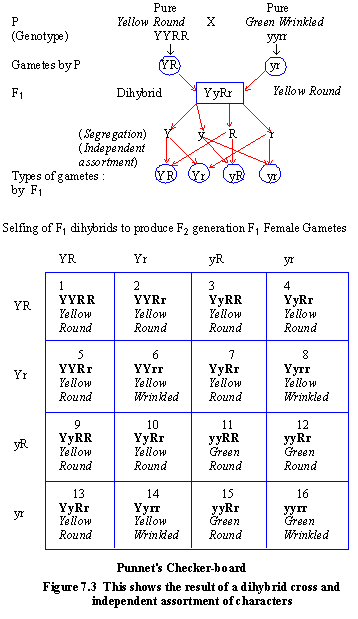|
PinkMonkey Online Study Guide-Biology
7.8 Law of Independent Assortment
"When a dihybrid (or a polyhybrid ) forms gametes,
(i) each gamete receives one allele from each allelic pair and (ii) the
assortment of the alleles of different traits during the gamete formation
is totally independent of their original combinations in the parents
In other words, each allele of any one pair is free to combine
with any allele from each of the remaining pairs during the formation
for the gametes
This is known as the Law of Independent Assortment of characters. It is also referred to as Mendelís third law of heredity.
Explanation of the law of independent assortment: The principle of independent assortment was explained by Mendel with the help of a dihybrid cross involving characters of cotyledon color (yellow / round) and seed shape (round / wrinkled).
Mendel crossed a true breeding variety of pea having yellow cotyledons (YY) and round seeds (RR) with another true breeding variety having green cotyledons (yy) and wrinkled seeds (rr). The complete result of this cross is shown in the Figure 7.3
Thus, the yellow round parent has the genotype (YYRR) and the
green wrinkled parent (yyrr). Since each parent is homozygous for
both characters (color and shape), each will produce only one type
of gametes. The (YYRR) parent will produce all (YR) type gametes
and the (yyrr) will produce all (yr) type gametes. All F1
dihybrids resulting from the fusion of these gametes would be double
heterozygous with (YyRr) genotype and appear yellow round. This
indicated that in the dihybrid cross also in each pair, the alleles
behaved exactly in the same way as in the monohybrid cross. Both
the dominants (Y and R) expressed themselves in F1
while both the recessive alleles (y and r ) remained
hidden.
Types of gametes formed by F1 dihybrid: According to Mendel, during gamete formation by the F1 dihybrid, the alleles in both pairs Y-y and R-r first segregate from each other (Law of segregation). Each pair segregates independently of the pair. Then the alleles enter the gametes. A gamete can receive only one allele from each pair, i.e. Y or y and R or r. Similarly, a gamete that receives a factor (gene) for color must also receive factor for shape (a factor for every character must be present in each gamete). Thus, a gamete that receives Y for color may receive R or r for shape. This would result in (YR) and (Yr) types of gametes. Similarly, a gamete that receives y for color may receive R or r for shape. This would give (yR) and (yr) types of gametes. In other words, the F1 dihybrid would produce four types of gametes (YR), (Yr), (yR) and (yr) in equal proportions. This is the principle of independent assortment of characters. There will be four types of male gametes and four types of female gametes formed by the F1 dihybrid.

|